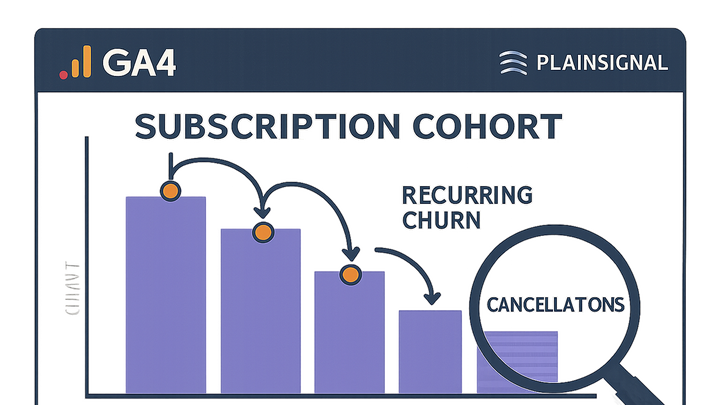Published on 2025-06-22T09:15:40Z
What is Recurring Churn? Analytics Examples with GA4 and PlainSignal
Recurring churn is a metric used in subscription-based analytics to measure the percentage of customers or revenue lost from a recurring subscription over a given period. It indicates how many users cancel or do not renew their subscriptions each month, quarter, or year. This metric is crucial for understanding the health and sustainability of SaaS and other subscription businesses. By analyzing recurring churn in tools like Google Analytics 4 (GA4) or a cookie-free platform such as PlainSignal, companies can monitor cancellation events, spot churn trends, and identify at-risk cohorts. While GA4 requires custom events and explorations to calculate churn, PlainSignal can track simple event-based cancellations with a lightweight, privacy-focused snippet. Monitoring recurring churn helps businesses optimize retention strategies, forecast revenue growth, and improve customer satisfaction.
Recurring churn
Rate of subscribers canceling recurring subscriptions over time, critical for SaaS retention and revenue health.
Why Recurring Churn Matters
Recurring churn is a key indicator of subscription health and growth potential. High churn rates can erode monthly recurring revenue and signal product or market issues. Understanding churn helps businesses identify risk patterns, allocate resources to retention strategies, and forecast revenue more accurately.
-
Impact on revenue
Monthly recurring churn directly reduces the predictable revenue base, making it harder to invest in growth.
-
Customer satisfaction indicator
A rising churn rate often reflects declining user satisfaction or increasing competition.
How to Calculate Recurring Churn
Recurring churn can be measured by the percentage of customers or revenue lost during a period. Commonly calculated monthly, this formula allows teams to standardize reporting and compare performance over time.
-
Basic churn formula
Recurring Churn Rate = (Number of churned subscribers during period / Number of subscribers at the start of period) × 100%
-
Choosing the period
Select a consistent period length such as monthly or quarterly to track trends accurately.
-
Subscriber vs revenue churn
Decide whether to count lost subscribers or lost MRR depending on your business priorities.
-
Tracking Recurring Churn with GA4
Google Analytics 4 does not provide churn metrics out of the box, but you can capture cancellation events and build custom churn reports using Explorations and segments.
-
Define cancellation events
Implement custom events like ‘subscription_cancel’ or use a refund event to mark churn actions and send them to GA4.
-
Create custom reports
Use the Analysis module (Explorations) to segment users based on churn events and calculate churn rates by cohort.
Tracking Recurring Churn with PlainSignal
PlainSignal is a privacy-focused, cookie-free analytics solution. By sending cancellation events to PlainSignal’s simple event API, you can count churn without complex tagging or cookies.
-
Install PlainSignal snippet
Add the following code to your HTML header to start tracking:
-
Code example
<script defer data-do="yourwebsitedomain.com" data-id="0GQV1xmtzQQ" data-api="//eu.plainsignal.com" src="//cdn.plainsignal.com/plainsignal-min.js"></script>
-
-
Send cancellation events
Use PlainSignal’s event API to emit a ‘subscription_cancel’ event with a unique user ID whenever a user cancels.
-
Event api usage
Use a POST request to PlainSignal’s event API endpoint with a JSON payload:
{ "event": "subscription_cancel", "userId": "USER123" }
-
-
Analyze churn data
Filter events by type and timeframe in the PlainSignal dashboard to calculate the churn rate for any period.
Best Practices to Reduce Recurring Churn
Lowering churn requires proactive engagement, continuous value delivery, and a focus on customer success. Implement these strategies to keep subscribers longer.
-
Effective onboarding
Guide new users through key features with in-app tours, emails, and documentation to demonstrate value quickly.
-
Gather user feedback
Deploy NPS surveys and exit interviews to understand why users are leaving and address pain points.
-
Proactive engagement
Use targeted messaging and campaigns to re-engage users showing signs of disengagement before they churn.
